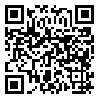Volume 19, Issue 6 (2-2021)
TB 2021, 19(6): 1-14 |
Back to browse issues page
Ethics code: IR.SSU.SPH.REC
Download citation:
BibTeX | RIS | EndNote | Medlars | ProCite | Reference Manager | RefWorks
Send citation to:



BibTeX | RIS | EndNote | Medlars | ProCite | Reference Manager | RefWorks
Send citation to:
Mazloomy Mahmoodabad S S, Vahedian-Shahroodi M, Ghaneian M T, Minaei M, Amani Dohesaran M. Study of Ecological Factors Associated with Leishmaniosis in Fariman Township during 2006-2018. TB 2021; 19 (6) :1-14
URL: http://tbj.ssu.ac.ir/article-1-2985-en.html
URL: http://tbj.ssu.ac.ir/article-1-2985-en.html
Seyed Saeed Mazloomy Mahmoodabad 

 , Mohammad Vahedian-Shahroodi
, Mohammad Vahedian-Shahroodi 

 , Mohammad Taghi Ghaneian
, Mohammad Taghi Ghaneian 

 , Masoud Minaei
, Masoud Minaei 

 , Mohammad Amani Dohesaran *
, Mohammad Amani Dohesaran * 




 , Mohammad Vahedian-Shahroodi
, Mohammad Vahedian-Shahroodi 

 , Mohammad Taghi Ghaneian
, Mohammad Taghi Ghaneian 

 , Masoud Minaei
, Masoud Minaei 

 , Mohammad Amani Dohesaran *
, Mohammad Amani Dohesaran * 


fariman , amanim2@mums.ac.ir
Abstract: (2874 Views)
Introduction: Ecological factors such as climate change as well as environmental, social, economic, and political factors are effective in increasing the incidence of Leishmaniasis disease in the Middle East. This study aimed to evaluate the ecological causes of leishmaniasis in Fariman town during 2006-2017.
Methods: In this descriptive-analytical study, all patients who were residents of Fariman and completed the Leishmaniasis Survey Form were included. The data of climatic variables of the town were extracted and analyzed using MS- Excel and SPSS software. Finally, the above information was plotted using Arc-GIS software.
Results: The highest incidence of cutaneous leishmaniasis in Fariman was 38.2% in 2009, while the lowest incidence rate was 12.0% in 2017. According to the incidence date, the disease was prevalent in the summer, spring, and autumn. Based on the diagnosis date, the disease had a peak in spring, winter, autumn, and summer. In this study, no relationship was found between the type of cutaneous leishmaniasis and any of the demographic variables. No significant relationship was also observed between climatic variables (temperature, humidity, precipitation), climatic factor of height, vegetation index, and Comprehensive plan in rural areas with leishmaniasis.
Conclusion: Given that most disease cases were in the urban area of Fariman and two rural areas of Ghale No and Kate shamshir, entomological examination is required in the area in order to make better use of the GIS. Furthermore, the overlap of relevant layers with other layers such as patients' accommodation and type of cutaneous leishmaniasis are required.
Methods: In this descriptive-analytical study, all patients who were residents of Fariman and completed the Leishmaniasis Survey Form were included. The data of climatic variables of the town were extracted and analyzed using MS- Excel and SPSS software. Finally, the above information was plotted using Arc-GIS software.
Results: The highest incidence of cutaneous leishmaniasis in Fariman was 38.2% in 2009, while the lowest incidence rate was 12.0% in 2017. According to the incidence date, the disease was prevalent in the summer, spring, and autumn. Based on the diagnosis date, the disease had a peak in spring, winter, autumn, and summer. In this study, no relationship was found between the type of cutaneous leishmaniasis and any of the demographic variables. No significant relationship was also observed between climatic variables (temperature, humidity, precipitation), climatic factor of height, vegetation index, and Comprehensive plan in rural areas with leishmaniasis.
Conclusion: Given that most disease cases were in the urban area of Fariman and two rural areas of Ghale No and Kate shamshir, entomological examination is required in the area in order to make better use of the GIS. Furthermore, the overlap of relevant layers with other layers such as patients' accommodation and type of cutaneous leishmaniasis are required.
Keywords: Cutaneous Leishmaniasis, Ecological Factors, Climate Change, Geographic Information System, Fariman County.
Type of Study: Applicable |
Subject:
Special
Received: 2020/07/3 | Accepted: 2020/08/27 | Published: 2021/02/28
Received: 2020/07/3 | Accepted: 2020/08/27 | Published: 2021/02/28
Send email to the article author
| Rights and permissions | |
 |
This work is licensed under a Creative Commons Attribution-NonCommercial 4.0 International License. |




